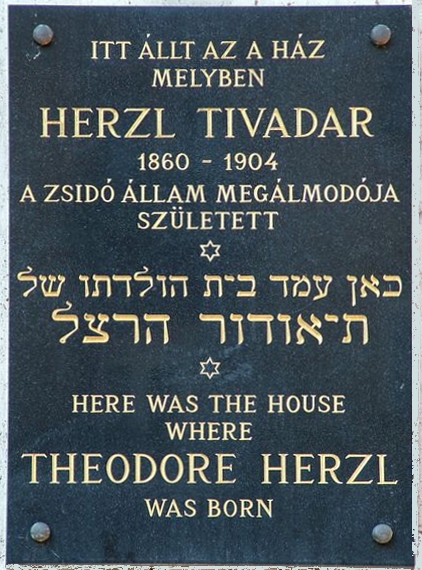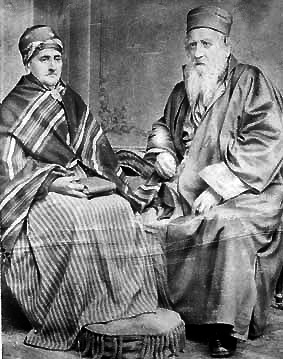|
Theodor Hertzl
Theodor Herzl; hu, Herzl Tivadar; Hebrew name given at his brit milah: Binyamin Ze'ev (2 May 1860 – 3 July 1904) was an Austro-Hungarian Jewish lawyer, journalist, playwright, political activist, and writer who was the father of modern political Zionism. Herzl formed the Zionist Organization and promoted Jewish immigration to Palestine in an effort to form a Jewish state. Although he died before Israel's establishment, he is known in Hebrew as (), . Herzl is specifically mentioned in the Israeli Declaration of Independence and is officially referred to as "the spiritual father of the Jewish State", Israel Ministry of Foreign Affairs, ''Declaration of Establishment of State of Israel'/ref> i.e. the 'visionary' who gave a concrete, practicable platform and framework to political Zionism. However, he was not the first Zionist theoretician or activist; scholars, many of them religious such as rabbis Yehuda Bibas, Zvi Hirsch Kalischer and Judah Alkalai, promoted a range of ... [...More Info...] [...Related Items...] OR: [Wikipedia] [Google] [Baidu] |
Pest, Hungary
Pest () is the eastern, mostly flat part of Budapest, Hungary, comprising about two-thirds of the city's territory. It is separated from Buda and Óbuda, the western parts of Budapest, by the Danube River. Among its most notable sights are the Inner City, the Hungarian Parliament Building, Heroes' Square and Andrássy Avenue. In colloquial Hungarian, "Pest" is often used for the whole capital of Budapest. The three parts of Budapest (Pest, Buda, Óbuda) united in 1873. Etymology According to Ptolemy the settlement was called ''Pession'' in ancient times ( Contra-Aquincum). Alternatively, the name ''Pest'' may have come from a Slavic word meaning "furnace", "oven" (Bulgarian ; Serbian /''peć''; Croatian ''peć''), related to the word (meaning "cave"), probably with reference to a local cave where fire burned. The spelling ''Pesth'' was occasionally used in English, even as late as the early 20th century, although it is now considered archaic. History Pest was original ... [...More Info...] [...Related Items...] OR: [Wikipedia] [Google] [Baidu] |
Aliyah
Aliyah (, ; he, עֲלִיָּה ''ʿălīyyā'', ) is the immigration of Jews from the diaspora to, historically, the geographical Land of Israel, which is in the modern era chiefly represented by the State of Israel. Traditionally described as "the act of going up" (towards the Jewish holy city of Jerusalem), moving to the Land of Israel or "making aliyah" is one of the most basic tenets of Zionism. The opposite action—emigration by Jews from the Land of Israel—is referred to in the Hebrew language as '' yerida'' (). The Law of Return that was passed by the Israeli parliament in 1950 gives all diaspora Jews, as well as their children and grandchildren, the right to relocate to Israel and acquire Israeli citizenship on the basis of connecting to their Jewish identity. For much of their history, most Jews have lived in the diaspora outside of the Land of Israel due to various historical conflicts that led to their persecution alongside multiple instances of exp ... [...More Info...] [...Related Items...] OR: [Wikipedia] [Google] [Baidu] |
Belgrade
Belgrade ( , ;, ; Names of European cities in different languages: B, names in other languages) is the Capital city, capital and List of cities in Serbia, largest city in Serbia. It is located at the confluence of the Sava and Danube rivers and the crossroads of the Pannonian Basin, Pannonian Plain and the Balkan Peninsula. Nearly 1,166,763 million people live within the administrative limits of the City of Belgrade. It is the third largest of all List of cities and towns on Danube river, cities on the Danube river. Belgrade is one of the List of oldest continuously inhabited cities, oldest continuously inhabited cities in Europe and the world. One of the most important prehistoric cultures of Europe, the Vinča culture, evolved within the Belgrade area in the 6th millennium BC. In antiquity, Thracians, Thraco-Dacians inhabited the region and, after 279 BC, Celts settled the city, naming it ''Singidunum, Singidūn''. It was Roman Serbia, conquered by the Romans under the reign ... [...More Info...] [...Related Items...] OR: [Wikipedia] [Google] [Baidu] |
Zemun Cemetery
Zemun Cemetery is a public cemetery situated in Zemun on the Gardoš, Gardoš Hill. It is bounded by Stefan Dušan, Cara Dušana Street, Nada Dimić, Nade Dimić Street, John Hunyadi, Sibinjanin Janka Street and Grobljanska Street, as well as with the staircase towards the Branko Radičević, Branka Radičevića Square, thus making the northwest boundary of the Old Core of Zemun. The cemetery is proclaimed the National heritage site, cultural monument. Introduction Before 1740, the cemetery was located on the low slope of the Gardoš, Gardoš Hill. In the mid-18th century on the tableland of the Gardoš hill a complex was formed, consisting of two Cemetery, cemeteries, for three Creed, confessions: Orthodoxy, Orthodox, Catholic (term), Catholic and Jews, Hebrew, which remained in function even nowadays. The defence wall with loopholes and bastions from 1841, saved as the cemetery enclosure, represents one of the last preserved parts of the city walls which used to surround entire ... [...More Info...] [...Related Items...] OR: [Wikipedia] [Google] [Baidu] |
Proto-Zionism
Proto-Zionism (or Forerunner of Zionism; he, מְבַשְרֵי הציונות, pronounced: ''Mevasrei ha-Tzionut'') is a term attributed to the ideas of a group of men deeply affected by the idea of modern nationalism spread in Europe in the 19th century as they sought to establish a Jewish homeland in the Land of Israel. The central activity of these men was between the years 1860 to 1874, before the Zionist movement established practical (1881) and political Zionism (1896). It is for this reason that they are called precursors of Zionism, or proto-Zionists. While the 17th century raised the overall idea, among Jews and non-Jews, of "restoring the Jews to Israel naturally by settlement and political action," the ultimate goal was not yet clearly defined. These ideas did not unite people to action and relied on the national project and the State (the Jewish nation). Therefore, the figures behind these ideas are not considered as Heralds of Zionism. This group of men considered ... [...More Info...] [...Related Items...] OR: [Wikipedia] [Google] [Baidu] |
Judah Alkalai
Judah ben Solomon Chai Alkalai (1798 – October 1878) was a Sephardic Jewish rabbi, and one of the influential precursors of modern Zionism along with the Prussian Rabbi Zvi Hirsch Kalischer. Although he was a Sephardic Jew, he played an important role in a process widely attributed to the Ashkenazi Jews. Alkalai became noted through his advocacy in favor of the restoration of the Jews to the Land of Israel. By reason of some of his projects, he may justly be regarded as one of the precursors of the modern Zionists such as Theodor Herzl. Biography Yehuda Alkalai was born in Sarajevo in 1798. At that time Bosnia was ruled by the Ottoman Empire. He studied in Jerusalem, which also belonged to the Ottoman Turkish Empire, under different rabbis and came under the influence of the Kabbalah. In 1825 he became reader and teacher at the Sephardic community of Semlin, and then its rabbi a few years later. Semlin, today's Zemun district of the Serbian capital Belgrade, was at that time ... [...More Info...] [...Related Items...] OR: [Wikipedia] [Google] [Baidu] |
Zvi Hirsch Kalischer
Zvi (Zwi) Hirsch Kalischer (24 March 1795 – 16 October 1874) was an Orthodox German rabbi who expressed views, from a religious perspective, in favour of the Jewish re-settlement of the Land of Israel, which predate Theodor Herzl and the Zionist movement. He was the grandfather of Salomon Kalischer. Life Kalischer was born in Lissa in the Prussian Province of Posen (now Leszno in Poland). Destined for the rabbinate, he received his Talmudic education from Jacob of Lissa and Rabbi Akiva Eiger of Posen. After his marriage he left Jacob of Lissa and settled in Thorn, a city on the Vistula River, then in Prussia and now Toruń, in northern Poland, where he spent the rest of his life. In Toruń, he took an active interest in the affairs of the Jewish community, and for more than forty years held the office of ''Rabbinatsverweser'' ("acting rabbi"). Disinterestedness was a prominent feature of his character; he refused to accept any remuneration for his services. His wife, by mea ... [...More Info...] [...Related Items...] OR: [Wikipedia] [Google] [Baidu] |
Yehuda Bibas
Yehuda Aryeh Leon Bibas (or Judah Bibas) ( he, יהודה אריה ליאון ביבאס) (1789 – April 6, 1852) was a Sephardic rabbi, the rabbi of Corfu and was the first of the precursors of modern Zionism. Biography Early life Bibas was born in Gibraltar to Sephardi Jews who were descendants of Jews expelled from Spain and had settled in North Africa. One of his maternal ancestors was Chaim ibn Attar. His father came from a line of Rabbis in Tétouan that emigrated to Gibraltar after a pogrom against the Jews that followed the invasion of the city by Spain. Bibas studied as a child in Gibraltar and after the death of his father he moved to Livorno to live with his grandfather. Livorno had a very prestigious and educated Jewish community. Bibas received in Livorno most of his Jewish and secular education, including his title as a physician. He then returned to Gibraltar where he established himself as the Rosh yeshiva. His Yeshiva was attended by students from England, Ita ... [...More Info...] [...Related Items...] OR: [Wikipedia] [Google] [Baidu] |
Rabbi
A rabbi () is a spiritual leader or religious teacher in Judaism. One becomes a rabbi by being ordained by another rabbi – known as ''semikha'' – following a course of study of Jewish history and texts such as the Talmud. The basic form of the rabbi developed in the Pharisees, Pharisaic (167 BCE–73 CE) and Talmudic (70–640 CE) eras, when learned teachers assembled to codify Judaism's written and oral laws. The title "rabbi" was first used in the first century CE. In more recent centuries, the duties of a rabbi became increasingly influenced by the duties of the Clergy, Protestant Christian minister, hence the title "pulpit rabbis", and in 19th-century Germany and the United States rabbinic activities including sermons, pastoral counseling, and representing the community to the outside, all increased in importance. Within the various Jewish denominations, there are different requirements for rabbinic ordination, and differences in opinion regarding who is recognized as ... [...More Info...] [...Related Items...] OR: [Wikipedia] [Google] [Baidu] |



.jpg)


